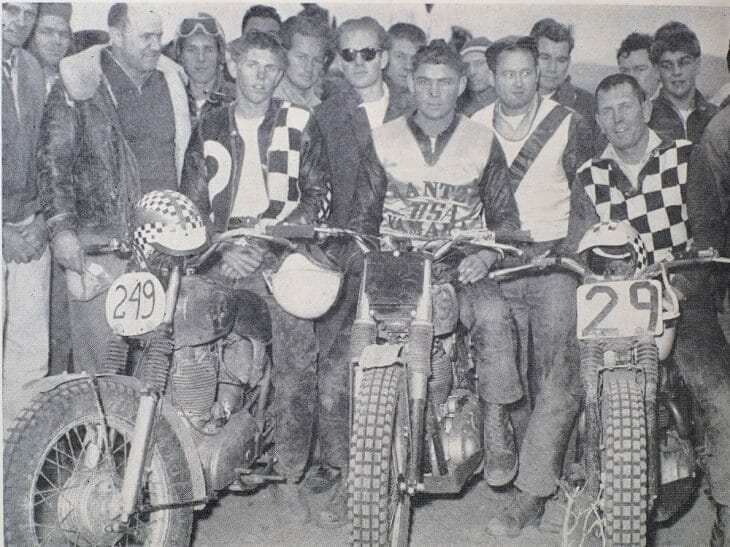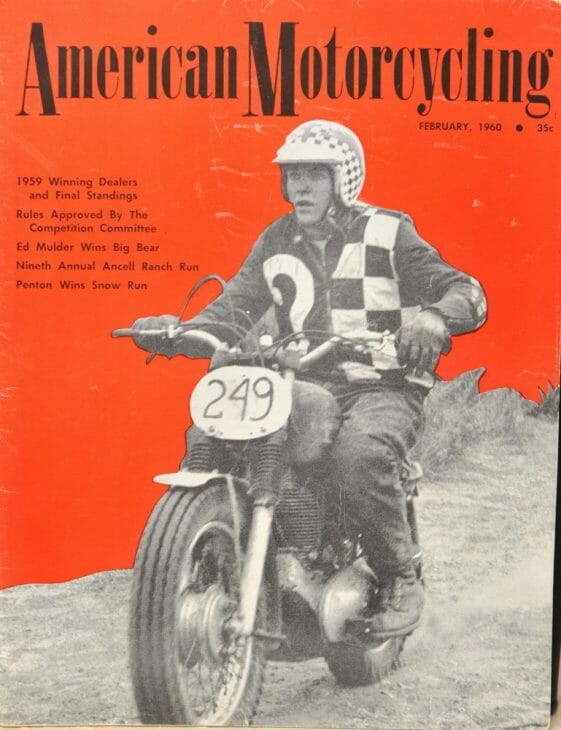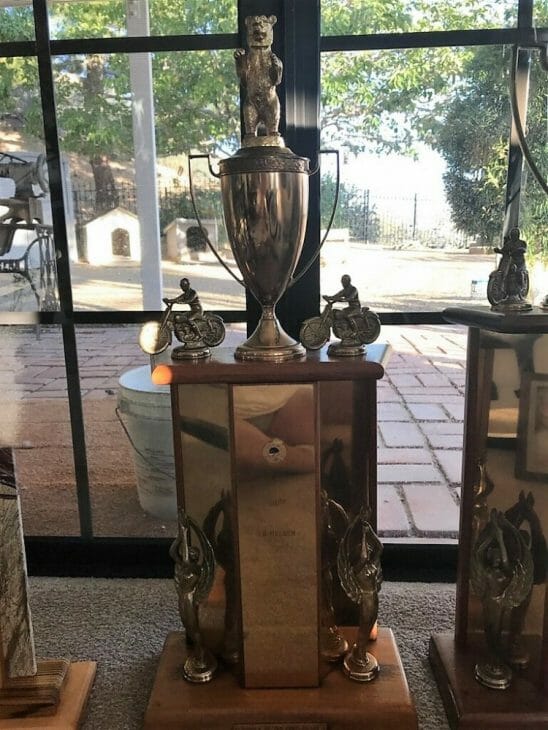Larry Lawrence | October 25, 2017
 Eddie Mulder (No. 249) poses with other competitors after winning the prestigious Big Bear National in 1960.
Eddie Mulder (No. 249) poses with other competitors after winning the prestigious Big Bear National in 1960.
We think of kids in their teens racing at the pro level a fairly recent phenomenon. You know the mentality – start them racing a five and by the time they’re 15 they already have a decade’s worth of racing experience. But young racing prodigies didn’t start in the ‘90s or 2000s. Eddie Mulder is proof of that.
Back in January of 1960, a fresh-faced kid from Lancaster, California, just 16, scored a stunning victory in one of the biggest motorcycle races in America, the Big Bear Run. It wasn’t just the fact that a 16-year-old Mulder beat the top desert racers of the era that was the story, it was the way he’d done it – coming from behind after losing a footpeg on his Mel Dinesen-tuned Royal Enfield in the middle of the race, and passing hundreds of fellow competitors to take the champion’s trophy at one of the most important races in America.
Overnight Mulder went from an obscure kid playing around on his motorcycle in the desert, to having his face plastered all over the country in motorcycle magazines and win posters celebrating the unlikely victory.
“It was big man,” Mulder says today when looking back on his Big Bear victory. “After that things just sort of snowballed, the sponsorships came rolling in and my career was off and running.”
The Big Bear first ran in 1921. Legend has it that a group of riders were together celebrating the new year when they decided to go out and see who could be the first to compete the 100-mile ride to Big Bear Lake. Helped along by annually being the first big race of the year (usually right after New Year’s), the Big Bear quickly grew into one of the most publicized races in the country.
 Eddie Mulder went from being a snot-nosed kid playing around in the desert on his dirt bike, to having his face on magazine covers after winning the Big Bear when he was just 16.
Eddie Mulder went from being a snot-nosed kid playing around in the desert on his dirt bike, to having his face on magazine covers after winning the Big Bear when he was just 16.
Riders who won what would become called the Big Bear National became well-known names in motorcycle-racing circles. Riders Like Dick Page, Dutch Sterner, Aub LeBard, Del Kuhn, Vern Robison and Bud Ekins. By the 1960 edition of the race, it had almost gotten out of hand. A total of 765 riders took the start of that year’s race. Only 207 crossed the finish line 150 grueling miles later. The race became so big in fact, that it was one of the things that caused its demise with police complaining of crowd control as a major issue.
The high desert of the Lucerne Valley, just outside Hesperia, California, was the start of Big Bear National in 1960. The race that year made three big cloverleafs over the sagebrush of the desert floor, with one section heading up the mountainside towards Big Bear Lake (where the race used to end before it got too big) via the ominously named Rattlesnake Canyon.
Hundreds upon hundreds of riders and their crews assembled in the freezing pre-dawn hours, hauling their bikes in pickups, trailers, or stuffed in sideways in the back of a station wagon.
As was the tradition of Hare and Hound races, the exact route of the Big Bear was kept secret, marked by sacks of lime only a few hours before the start. The site and sounds of nearly 800 racers taking off across the desert floor, in what well have been, by sheer numbers alone, the biggest motorcycle race in the world, was something to behold.
Multi-time winner Bud Ekins, on his Triumph, was the first rider into the first gas check with Hare and Hound veteran Wayne Harris close behind on his Royal Enfield. Harris took the lead in the middle stages of the race, but was later undone after hitting an unseen boulder. Buck Smith then led for a time before the gas tank on his Triumph split open. Then it was Don Surplice taking the point, just about the time his Matchless suffered a mechanical breakdown.
 Mulder still has his Big Bear trophy on display at his house.
Mulder still has his Big Bear trophy on display at his house.
By then Mulder was playing a game of catch up.
“Just after the second loop I broke the right footpeg off,” Mulder explained. “I came back and told my crew and they found a footpeg and when I came back in to get gas to start the third loop they put on a new footpeg.”
That meant Mulder had ridden 50 miles. A full third of the race, without a footpeg! He was riding some of the roughest desert trails resting his right foot atop the Enfield’s gearbox.
It was up the steep ascent of Rattlesnake Canyon on the final loop, where Mulder, on the charge with his repaired bike, moved up to battle the BSA of Babe Jay. The two swapped the lead several times on the uphill loop, but Mulder was bolder and faster on the downhill sections and took command of the race.
Mulder would pull away to win over Jay and third-place Darrell Triber.
Mulder remembers one particularly funny moment at the winner’s celebration.
“We were there getting our pictures taken and Frank Cooper (Royal Enfield distributer) was all excited. The big spender that he was, he reached over and handed me a 20-dollar bill for winning the Big Bear!”
On the surface it seemed almost impossible that a 16-year-old whippersnapper could win an event as significant as the Big Bear, but Mulder was no rookie at the game. He grew up riding countless hours in the Antelope Valley and had been racing from the time he was 12. Perhaps Mulder was simply too young to feel the pressure of racing in an event of such importance.
Mulder continued racing and winning in the desert until he was 18, when he turned pro and started his successful run in pro flat track racing.
As for the Big Bear, the future looked bright, until it wasn’t. Sports Illustrated sent a reporter to cover the 1961 event and it was a complete disaster. Some riders jumped the start and scoring went haywire. The title of the resulting SI story was “Debacle in the Desert”. The ’61 race was declared a non-event and with it came the end to the storied race.
Luckily for Mulder the race served as a launching pad to a Hall of Fame career, which included five AMA Grand National wins, including two at the prestigious Peoria TT National.
Yet in spite of all the success he would have on the Grand National level, he still looks back at his win in the 1960 Big Bear as perhaps his biggest.
“You look back at the photos and I was just a dumb desert kid, fast as lightning,” Mulder said. “I didn’t realize it at the time, but winning that race opened a lot of doors for me.”
You can read more about the history of the sport by subscribing to the Cycle News Archives at: https://www.cyclenews.com/cycle-news-archives/